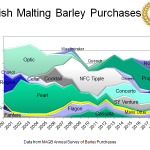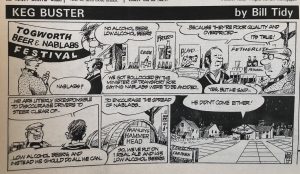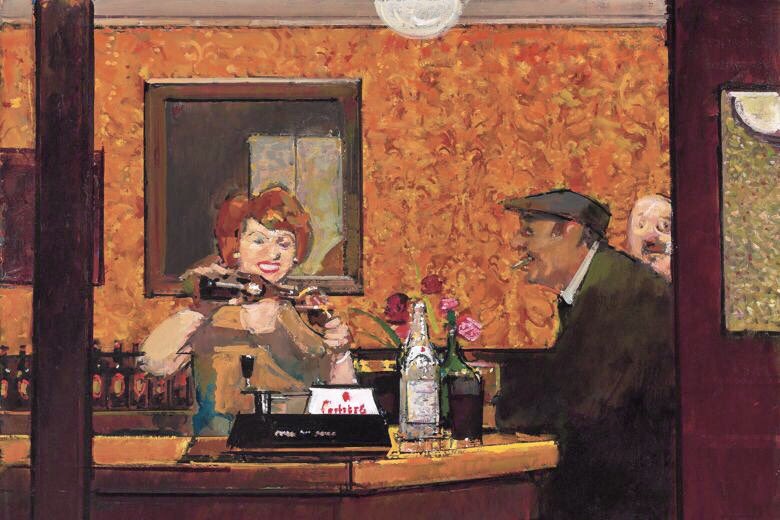 I have been burning off unused holidays built up over the months of the early times, back when there were no days or even hours to be had. This week, I motored 20 km west, over to MacKinnon Brothers to pick up gifty swag and chatted briefly about business with brother Dan, the brother who joined the 1780 challenge and pretendy stabbed the rebellious Craig for the camera. They brew on the lands the family has farmed since the 1780s when they first arrived as Anglo-American Loyalist refugees. The site has got to be one of the most attractive in all of brewing-dom, especially with the new barn space upgrades Dan showed me and that just slightly less new build cathedral-like reception building. Gorgeous. More images below.
I have been burning off unused holidays built up over the months of the early times, back when there were no days or even hours to be had. This week, I motored 20 km west, over to MacKinnon Brothers to pick up gifty swag and chatted briefly about business with brother Dan, the brother who joined the 1780 challenge and pretendy stabbed the rebellious Craig for the camera. They brew on the lands the family has farmed since the 1780s when they first arrived as Anglo-American Loyalist refugees. The site has got to be one of the most attractive in all of brewing-dom, especially with the new barn space upgrades Dan showed me and that just slightly less new build cathedral-like reception building. Gorgeous. More images below.
Other than that, it has been a quiet week in my corner of the universe. Some Tuesdays I open up my folder for the weekly round up and find thirty things to consider. Others, not so much. Let’s see what’s up? First up, our local government run store started and stopped a ill-considered deal with Skip The Dishes, a meal delivery service, providing a way for prepared food and food-like objects to be delivered to Ontarians with some hootch. Not no more – and with good reason:
Through the partnership, customers could have ordered alcohol from the SkipTheDishes app and website. The partnership caused consternation in the restaurant and bar industry, which has been relying in part on the sale of alcohol through takeout and delivery to pay its bills. “Following direction from the Ontario Government, effective end of day today, LCBO’s partnership with SkipTheDishes is paused until further notice,” the LCBO said in a statement on Sunday.
In other offices elsewhere, folk are more successfully branching out to keep the lights on. I have to say, I have no idea who the market is for the Cicerone Explore Beer which, for $25 gets you a digital badge… but not decoder ring. The next level up, the Certified Beer Server program is simple enough for anyone needing such things. Also – and this one really does me in – one of those blogs that pretends it’s a magazine, Hop Culture, has sold. Fruit juice oriented stuff. Scan my site. Never referenced it. Often times, these sales are for the IP to the name or the URL rights so go figure.
Much more substantive is the piece in this week’s Pellicle (of which I have to admit I am a low-mid-level patron, my only such dalliance), a neato exploration of the Neomexicanus hop of New Mexico which Stan has written of some years ago now:
I’m stunned by this revelation. The hop bines I’m looking at—while not at their most majestic—are very much viable and alive. It seems like a miracle. For other varieties, surely such water deprivation would leave nothing but a shrivelled brown mess? “If I had Chinook or Cascade and had the same situation where I lost water, they would probably die” Brain agrees. As we climb back into the Mule, I’m bristling with excitement for what I’ve just seen; hops deprived of water for many weeks that are alive and well.
[Note to self: I need to search the Pellicle sight to see how many things have “stunned” its cadre of authors but “bristling” might be a new one.]
And as for the man who will never sell*, The Beer Nut has launched and investigation into the clone beers of grocer Aldi and finds the relationship is only branding-deep:
What a jape! What an absolute wheeze! When discount supermarket Aldi brought out obvious knock-offs of BrewDog’s flagship beers Punk IPA and Elvis Juice, the Scottish brewer retaliated with ALD IPA, appropriating the German chain’s company livery. Suspiciously soon afterwards, Aldi agreed to begin stocking ALD alongside their specially-commissioned BrewDog doppelgangers, Anti-Establishment IPA and Memphis Blvd. It seemed like a perfect opportunity for some blind-taste fun, to find out if Aldi really can go toe-to-toe with a brewery of BrewDog’s stature. Of course, the recipes of Anti-Establishment and ALD have nothing at all in common with each other, and the beers look very different: one a russet amber, the other purest spun gold.
The question of whether Scotch eggs are a “substantial meal” has popped up again and again given England’s pandemic rules. Law. This story about the situation at the establishment Number 29, in Burnham Market, Norfolk illustrates how frustrating such as vague standard is for all involved:
Mr Roberts, 62, says he refused the two ‘black-booted bouncers’ entry and after a confrontation escorted them off his premises. The former fireman said: ‘They said they wanted to come in but I said they did not have the right of entry….” He added: “I took the commercial decision to offer a free Scotch egg, either with chips or with a salad, to anyone who wanted a drink. I’d call that a meal. Two government ministers have said a Scotch egg is a substantial meal. That’s good enough for me.”
More beer law! I hear it’s what the cool kids want. Wine Enthusiast has published an article on one of craft’s dirty secrets, the commonly sticky hands even when the goods are intangible:
Palfreyman, the attorney who works with breweries on trademark issues, says the key to avoid problems is “common sense.” Think before you print or post, he says. Ask for input from attorneys, or someone from outside of the company first. Breweries that push these boundaries “might find something funny about what they are doing, or think it’s an homage,” he says, but they’ll find that corporations that own and defend their trademarks “are humorless.”
Ha ha. So funny. Me make money off your skill and efforts. Not unrelated, I like the thinking being applied in Thailand as they consider the advertising taxation of no-alcohol beer:
Beer companies could have one non-alcoholic product advertised legally at the same time as an alcoholic product creating a link in the audience’s mind to the product that are restricted from advertising.
Conversion. That’s what lawyers call these sorts of cheater pants allegations! Or appropriation. Or… something… not that different from swiping the intellectual property of another if you think about it. And in Kenya, the rules about trying to control the image on embossed beer bottles are being considered in court:
Minor players have over the years been pointing fingers at East African Breweries Limited (EABL) for engraving this type of bottle with its trademark bottling out rivals. This has led to long-winding legal battle on whether EABL is legally allowed to do so. In January this year, High Court Judge Grace Nzioka ruled that EABL had the right to collect and package their beer brands in their embossed bottles pending determination of a case in which six beer distributors affiliated to Keroche Breweries had challenged the move.
Finally, some bad direct adulteration news out of Brazil for at least three fans of craft beer:
A third person has died in Brazil of suspected poisoning from a batch of craft beer contaminated with a toxic chemical used in antifreeze and other products, police in the state of Minas Gerais said on Thursday… Traces of the sweet-tasting solvent were found in the water tank used by the Backer brewery, whose craft beers have won international prizes and are widely available in Brazil.
Not good. But that’s it for the week so you can cogitate your knogging on that for the next seven days. As always, for more good reading check out the weekly updates from Boak and Bailey mostly every Saturday, plus more at the OCBG Podcast on Tuesday and sometimes on a Friday posts at The Fizz as well. And sign up for Katie’s weekly newsletter (except last week because she is busy with opening her new bar business), The Gulp, too. Plus the venerable Full Pint podcast. And Fermentation Radio with Emma Inch. There’s the AfroBeerChick podcast as well! And have a look at Brewsround and Cabin Fever. And Ben has his own podcast, Beer and Badword. And remember BeerEdge, too. Go!
*Sell out… I meant to write sell out… really…

















